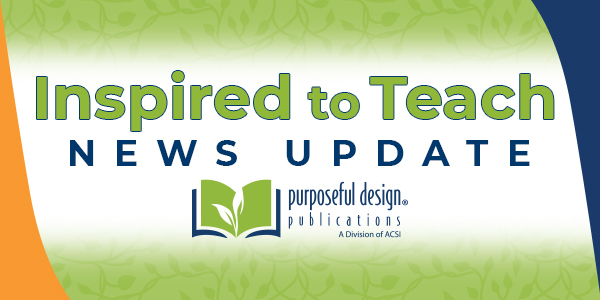
Inspired to Teach News Update - Fall 2022


Lisa Wood
Assistant Vice President
Purposeful Design
Hello, I’m Lisa Wood, Assistant Vice President of Purposeful Design Publications. I am so excited to share with you a new resource designed specifically for Christian Educators. It’s our “Inspired to Teach” digital news update! This communication format has been created to inspire Christian educators with educational strategies and tips for biblical worldview integration. We want to bring you awareness of latest educational research; comments from Christian leaders and influencers; information about digital resources, textbooks, and training opportunities as well as meaningful nuggets to keep you inspired for the great work you do in transforming young lives to serve Jesus Christ.
Take a look around, and please share feedback so we can continue to make this the digital news update that Christian educators connect with regularly. Have a blessed day!

Powerful Reading Strategies to Launch a Successful School Year
The rewarding work of motivating students to read begins with connecting them to books that genuinely reflect their interests, then giving students numerous titles and genres from which to choose. Students can encounter a variety of high interest topics that span multiple levels of text complexity when teachers become flexible with reading levels. A willingness to try new teaching strategies is a powerful way for teachers to provide the highest quality of education. These six research-based reading strategies work well with students.
#1 Reading accountability partners: Have students meet briefly with partners to discuss prior reading assignments. Pair students who will encourage and challenge one another. When introducing this strategy, teach a mini-lesson to help students understand their roles and learn how to hold peers accountable. Provide examples of questions students should ask and teach students how to be receptive to feedback. While students hold discussions, circulate to keep students on task and in focused conversations. Click to read more
#2 Choral reading: With this strategy, a teacher and students read a passage aloud together. Choral reading enables teachers to introduce students to longer passages, thus increasing students’ reading stamina while decreasing individual fluency issues. When students read aloud together, they also improve their decoding skills by learning from each other. To vary the activity, omit words during choral reading and have students say the omitted words chorally either as a whole group or in smaller groups. As students become more familiar with passages, encourage them to vary the pitch, sound, and volume of their voices as they reread.
#3 Scaffolded silent reading: Silent reading is so important, but before sending students off with a book to read silently, scaffold their reading. Pre-teach vocabulary, provide a plot overview, and even introduce the reading with a K-W-L activity.
#4 Reading buddies: Set aside time each month for upper-grade and lower-grade classes to read together. This strategy builds community and is a powerful literacy tool. It gives older struggling readers access to easier content without stigma while sharing with a novice reader. Allowing younger students to choose a book to read engages them and gives them opportunities to hear fluent reading while their older peer models reading.
#5 Building background knowledge: Try pre-teaching key vocabulary and concepts and linking new, unfamiliar material to material students have already learned. Help students make text connections from personal and shared experiences.
#6 Read-alouds: A powerful reading strategy for students of all ages to engage in reading is to model excitement and interest by reading aloud a book you love and think your students will enjoy. Teachers communicate their interest in a book’s
content by reading aloud. Using an enthusiastic voice, and a variety of voices, conveys excitement about reading and a fascination with the topic. Well-done read-alouds also offer prompts so that students learn how to think about the text. This helps
increase student comprehension.
Purposeful Design Publications’ comprehensive English Language Arts program naturally embeds these reading strategies and additional instructional strategies into their Literature Guides and Reader
Guides. They provide a plethora of opportunities for teachers to easily implement these strategies. Teaching students to read and enjoy reading gives students a most valuable tool that enables them to read God’s message and fully understand
His plan and desire to redeem His creation back to Himself.
Source: Edutopia
4 Reading Strategies to Retire This Year (Plus 6 to Try Out!)
A look at a few popular literacy practices that shouldn’t make
the cut—
along with fresh strategies that experienced teachers and literacy experts
recommend instead.
By Sarah Gonser
August 12, 2021

Grade 4 Language Arts
Fall Featured Product
Language Arts is the key to unlocking a world of knowledge, understanding, and adventure. Purposeful Design Publications’ Language Arts series provides a structured, systematic, and cumulative approach to teaching reading. The key components of the program include phonics, spelling, vocabulary, grammar, writing, reading, and literature.
Our robust and comprehensive program assists teachers and parents in establishing a practical basis for phonics, reading strategies, and the crafts of written and oral communication. It includes best practices for every grade level and raises the bar well above basic standards.
Daily Lesson Components:
Reading skills, Literature Guides, Reader Guides, Grammar, Writing, Spelling, and Vocabulary Builder
The daily lesson components of the series provide students the opportunity to discuss and interact with a variety of texts they read, write, or hear read aloud to them. As students talk about texts, they learn to better understand ideas and share their thoughts more effectively. Students also acquire the skills to discuss and write about texts, which allows them to process new ideas and expand their learning by interacting with others.
Standards:
Purposeful Design’s Language Arts Series incorporates comprehensive components: research-based phonics instruction, implicit and explicit vocabulary instruction, systematic spelling instruction, integrated grammar and writing instruction, engaging literature, and a comprehensive reading program. The series meets or exceeds national standards – National Council of Teachers of English (NCTE) AND College and Career Readiness standards. PDP’s reading component is a comprehensive program that knits together guided, shared, and independent reading with inspiring literature to meet rigorous national literacy standards. Its multimodal reading program provides systematic instruction in phonemic awareness, phonics, reading fluency, vocabulary, and reading comprehension while building students’ knowledge of God’s wonderful world.
Program Components:
- TWO Teacher Editions – Language and Writing AND Reading and Literature
- TWO Student Editions – Language and Writing (and spelling) AND Reading Skills
*Both Language and Writing and Reading and Literature are necessary for the fully comprehensive program, however, users can choose to use either/or as separate modules.
Language and Writing Components:
- Grammar and Writing – Grammar and writing instruction includes in-depth but grade-appropriate grammar lessons and robust writing activities for students to engage in practicing correct language usage and structure. Diagramming sentences is a regular activity to engage students in fully understanding the parts of sentences. As students progress from grade to grade, their knowledge of parts of speech, correct punctuation, proofreading skills, sentence construction, and good paragraph formation within various writing forms increases. Grammar and writing concepts are taught, reviewed, and applied through spiraling and scaffolding instruction. The writing activities provide opportunities for students to apply the learned grammar concepts as well as to incorporate spelling and vocabulary words as appropriate. Students learn the writing process through copywork or modeled writing, interactive writing, brainstorming, drafting, and editing. Lessons also include instruction in using graphic organizers, correct language usage, word choice, writing conventions, and the writing and revising process.
- Spelling – Student pages are contained within the Language and Writing student edition. Word lists expand in length (from the K-3 levels) and are categorized into pattern words, high-frequency words, and power words. The lists include technology terms. Spelling activities and exercises are included in the language and writing student edition for these grades.
- Oral Vocabulary (Speaking and Listening) and Vocabulary Builder – Research bears evidence that students who have an expanding, broad vocabulary experience greater success in school and on standardized tests. The Purposeful Design Language Arts series offers regular and well-paced lessons for students to study words in context; to practice word meanings, synonyms, and antonyms; to make connections between words, and work with word parts from Latin and Greek to gain a better understanding of the richness of language.
Reading and Literature Components:
Reading Skills
- Phonics Refresher – Students review and practice previously taught phonics skills to refresh and strengthen these skills. A strong phonics progression includes grade-appropriate phonics concepts and decodable high-frequency words. High-frequency words that are not decodable and must be learned on the basis of letter recognition are taught separately in the Spelling component.
- Word Meaning – Students learn context clues strategies and apply them to determine the meaning of words within sentences or missing words within passages.
- Listening Comprehension – Short listening activities, as well as longer listening comprehension passages, help students learn to listen carefully and for specific information.
- Reading Comprehension – Both fiction and nonfiction texts in a variety of genres are included, along with accompanying questions and activities to help students develop reading comprehension and critical-thinking skills.
- Story Sequencing – Students sequence the events in a story or the information in a nonfiction text to practice reading carefully.
- Reading Fluency – Students learn and apply reading fluency strategies to increase their oral reading fluency skills.
- Assessment – This section guides teachers in evaluating students’ listening or reading comprehension progress.
- Student Pages Answer Key – Answers are provided on readable reductions of the student pages to allow easy access for grading.
LITERATURE and LITERATURE GUIDES (These are READ-ALOUDS)
Literature instruction is a valuable part of PDP’s Language Arts series. Through read-aloud books, the series promotes literacy awareness and introduces students to a robust selection of literature including a variety of genres, classic works, rich literature, and informational text.
There is tremendous value in introducing students to great literature and giving them the opportunity to discuss it. Each read-aloud picture book or chapter book has a literature guide designed to help teachers lead their classes to develop comprehension skills through discussion, open-ended questions, and activities related to inference skills, text connections, and appropriate theme connections. The literature lessons also include instruction and activities in oral vocabulary. To present related topics through different genres, some guides also include paired informational text or paired poetry selections and accompanying questions.
When students hear various genres of literature read aloud, it frees them from the need to decode and allows them to listen, think, learn, form opinions, and express their thoughts about the text. Literature discussions afford teachers the opportunity to assess students’ understanding and engagement with a text and to introduce and use academic language as they talk about the text. Engaging discussion and critical-thinking questions spawn a deeper understanding of content, vocabulary, and literary terms, often tying lessons to applicable biblical principles. This allows teachers to reinforce a biblical worldview by guiding students in critical thinking about the topics presented in each text.
The literature guide masters (LGMs) are available online. To scaffold comprehension and help in vocabulary instruction, Digital Masters (DMs) are also available online.
READERS and READER GUIDES (Novels that are purchased by the schools from another vendor)
The reader guides in this comprehensive reading program were purposefully written with the needs of elementary school readers in mind. The guides include highly engaging activities that instill in students an enjoyment of reading, guide students to learn basic features of printed materials, develop within students a strong foundation for the reading process, and expand students’ knowledge of God’s wonderful world.
These powerful tools have been carefully written to help teachers facilitate daily group discussions. The readers and reader guides introduce students to a variety of genres. The reader guides also deliver systematic instruction in reading fluency, vocabulary, and reading comprehension while building a solid foundation for literacy. These guides were designed to help teachers meet rigorous national literacy and college-and-career-readiness standards while supporting students’ needs and challenging them to increase their reading ability. The research-based lessons follow the recommendations of current reading research and best practices for reading instruction.
Diagnostic tests provide beginning-, middle-, and end-of-year evaluations of each student’s reading skill, phonics acumen, and progress. Information on how to administer each grade’s test is provided on the first page of the test.
Reader guide masters (RGMs) that support this instruction are also available online.
We partner with Curriculum Trak and have textbook maps for grades K-4 available for import as starter maps.



PDP Team on their way to volunteer at a local library. It was casual day for the
team!
Meet the ACSI Purposeful Design Publications team! Collectively, this group is made up of editors (all former teachers), graphic designers, publishers, and training coordinators. We are committed to providing your classroom with rigorous, standards-aligned, researched-based curriculum that strongly weaves a biblical worldview into all of its educational content. It is our prayer as a team that you continue to flourish as a Christian educator and that your students will make a lasting mark on society for Jesus Christ because of your devotion to Kingdom education.
We Are Stronger Together!
ACSI exists to strengthen Christian schools and equip Christian educators worldwide as they prepare students academically and inspire them to become devoted followers of Jesus Christ.
ACSI is intentional in its focus to support Christian educators in the development of a learning environment that distinctively reflects a biblical worldview and leads to spiritual formation. A biblical worldview gives leaders, teachers, students, and families the framework to think critically about ideology, information, relationships, personal situations, and global circumstances through the lens of understanding the supremacy of God, their relationship with Him, and the world He created. Spiritual formation is the process of becoming more Christlike, to bring glory to God and to impact relationships with others (2 Corinthians 3:17–18). Spiritual formation happens by the power of the Holy Spirit who guides a believer in their journey with God as they discover His plans and purposes for their life. The human response requires submission, and the journey takes a lifetime. The process is holistic and involves right thinking (head), right feelings (heart), and right behaviors (hands) toward individuals and communities. In an instructional setting, biblical worldview informs practices and is foundational to a flourishing learning environment.
For more than 30 years, Purposeful Design Publications (PDP), a division of ACSI, has provided academically rigorous textbooks that are intentionally rooted in biblical truth to equip educators with the tools to eternally transform the hearts and lives of children. Choosing the right textbooks is an important decision. You want the content to be rich and engaging but also full of activities and questions from which students can learn who God is, what He and His Kingdom are like, how to enter His Kingdom, and what to do once they are there. What is their purpose in life? What is their interaction with the world around them supposed to involve?
PDP textbooks guide students into understanding that a worldview is the lens through which they see and interpret the world. It is the deep values and beliefs that they hold (consciously or unconsciously). These values and beliefs then lead to how they think and feel. Those thoughts and feelings then lead to how they interpret what they see and how they then choose to act. A biblical worldview is one that acknowledges the authority of Scripture (the words/writings of the Bible) as the source of truth and uses it as the lens through which they attempt to understand and respond to their world. Because sin has impacted every human, no person will ever fully know the answer to every question of life from God’s perspective. As it says in 1 Corinthians 13:12, “…now I know in part, then I shall know fully.”
PDP textbooks include a three-pronged approach to integrating biblical content into their lessons: biblical connection, biblical integration, and biblical worldview integration. Let’s unpack each of these. Biblical connection equates to basic knowledge. When students learn something about the content of the Bible, they have made a biblical connection to it. For instance, if during the study of ancient civilizations, you mention that the historical figure of Sennacherib, king of Assyria and rebuilder of Nineveh, is recorded in the Bible in 2 Kings, 2 Chronicles, and Isaiah, you have made a biblical connection for students. They connect with the idea that history is recorded in the Bible.
Continuing on, biblical integration is incorporating Bible information with the subject matter of the lesson. Biblical integration is connected to understanding. When students can use what they know from the Bible to make an application of the subject matter in their lives, they have integrated their biblical knowledge. As an example, when studying math, students can recognize God’s nature in numeracy, facts, equations, order, patterns, and consistency. Genesis 6:14–16 describes Noah’s use of measurements, an application necessary to completing the ark. Also, when students study the life of Jesus on Earth and His frequent travels near or on the Sea of Galilee, they can research to find its length, width, and depth, and move on to calculate its perimeter, surface area, and volume of water.
Finally, and perhaps most importantly, biblical worldview integration is the application of seeing how the topic reveals the character or nature of God, who man is, the nature of the world, man’s purpose in life, the effects of sin and the promises of God, and how to evaluate what is true and how the discussion, presentation, or activity engages students to live in ways that honor God. For example, as students study literature, what biblical characteristics or needed godly character traits are revealed by the characters in a story? What does Scripture say about the protagonist’s behaviors, thoughts, and actions? How should Christians behave if they were in the same situation? What ramifications would their godly behavior or words or thoughts have on themselves and others? What is or would be a God-honoring response of the character? What impact could there be on the Kingdom of God if the character (or student) acts in a godly manner? Biblical worldview integration is connected to wisdom. Wisdom for living godly comes when knowledge and understanding of God’s Word become an integral part of a student’s heart. Godly wisdom should guide students in every action, choice, and thought.
Having presented what biblical worldview integration is, let’s look at what it is not.
- Bible verses at the top of a worksheet or used in diagramming a sentence in grammar
- Reading Bible verses printed on a tree diagram after a lesson studying the features of trees
- Referring to God’s greatness in general, broad terms. For example, teaching a lesson on compounds and mixtures and saying their properties reflect God’s greatness which, while true, is not specific enough to be a biblical worldview application
- Prayer and devotions in class
These are activities that point to the Bible in general and to God specifically, but they do not train the students in looking at the world around them to process the information through the purposes and plans of God.
In conclusion, I simply encourage you to ask students questions to bring them into greater knowledge of who God is, how to relate to Him personally, and how to engage others to think more deeply about Him and His great design of life. We will continue to explore this topic in upcoming newsletters.










